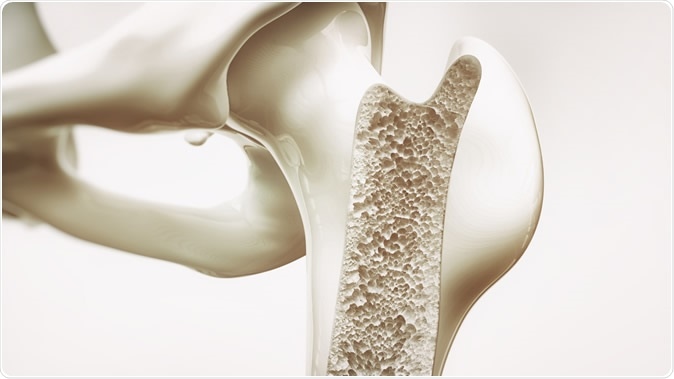Vitamin D – an essential for healthy bones and calcium in the body, is prepared by the body when the skin is exposed to sunlight. A daily exposure of around 10 to 15 days is considered to be adequate for fulfilling the needs of vitamin D in the body. This may hold true during the summers for Canadians, say experts but may not be true during the winters when sun exposure is markedly lower. For this many individuals may have to be provided with Vitamin D supplements.
The Health Canada recommends that all individuals take daily 600 international units (IU) of Vitamin D up to the age of 70 years which is raised to 800 IU after the age of 70 years. Osteoporosis Canada recommends that adults who are at risk of getting osteoporosis should take a daily 400 - 2,000 IU of Vitamin D. There is a confusion regarding the actual dosage of Vitamin D that should be taken and the risk of overdose.

Osteoporosis stage 3 of 4 - upper limb bones - 3d rendering - Illustration Credit: Crevis / Shutterstock
To understand this, the researchers from the Cumming School of Medicine's McCaig Institute for Bone and Joint Health conducted a new three year-long study and found that there are no additional benefits of taking in extra Vitamin D. The results of their study titled, “Effect of High-Dose Vitamin D Supplementation on Volumetric Bone Density and Bone Strength: A Randomized Clinical Trial,” was published in the latest issue of the Journal of the American Medical Association (JAMA).
Dr. David Hanley, endocrinologist in the Cumming School of Medicine (CSM) and one of the lead authors of the study said, “Although vitamin D may be involved in regulating many of the body's systems, it is the skeleton that is most clearly affected by vitamin D deficiency. Current Health Canada recommendations were set to prevent the bone diseases caused by vitamin D deficiency for the vast majority of healthy Canadians. But it has been more difficult to clearly establish the optimal dose of vitamin D. When we designed this study, there remained a question whether there's more benefit in taking a higher dose.”
The team of researchers included 311 participants in the study who were followed up between ages of 55 and 70. Their baseline levels of Vitamin D or 25-hydroxyvitamin D (25[OH]D) was 30 to 125 nmol/L. The study was a double blind randomized study. This meant that the participants were allocated to each of the study groups in a random manner and neither the participants nor the persons analyzing the information from the participants knew which groups the participants belonged to. This was to eliminate any form of bias. The whole study population was divided into three groups in which the participants were randomly allocated. One of the groups (109 participants) received 400 IU of vitamin D per day, another (100 participants) received 4,000 IU per day, and the third group (102 participants) received 10,000 IU of Vitamin D per day. Calcium supplementation was also provided to all the participants who had a dietary intake of less than 1200 mg per day.

The vitamin D research team: Back row (L to R) Emma Billington, Steven Boyd, Lauren Burt. Front row (L to R) Sarah Rose and David Hanley. Photo Credit: Nedaa Photography
Each of the participants had to undergo tests to look at their bone density and bone strength. This was done using high-resolution computed tomography (CT) scan of bone at the wrist and ankle, called an XtremeCT at the McCaig Institute's new Centre for Mobility and Joint Health. Bone density was measured using Standard dual-X-ray absorptiometry (DXA). The scans were performed at the beginning of the study and then again at 6 months, 1 year, 2 years and 3 years after the start of the study. The participants’ blood samples after an overnight fasting were collected and analyzed for vitamin D and calcium levels at the start of the study and then again at 3 months, 6 months, 1 year, 18 months, 2 years, 30 months and 3 years. Their urine samples were also collected simultaneously for calcium and Vitamin D assessment.
The researchers explained that lowered bone mineral density signified more brittle bones that were liable to easy fractures. Over the duration of the study the bone mineral density (BMD) declined for all the participants as is normal with age. This was evidence with the DXA scans. On XtremeCT however, the decrease in BMD was found to be 1.4 per cent in the 400 IU group, 2.6 in the 4,000 IU group and 3.6 in the 10,000 IU group. This meant that with higher doses of Vitamin D supplementation the BMD tended to be reducing faster. The team called for more research to establish this unexpected finding. The authors of the study concluded, “Among healthy adults, supplementation with higher doses of vitamin D did not result in improved bone health; further research would be needed to determine whether it is harmful.”
Further, those on the highest doses of the Vitamin D (the 4000 IU and 10,000 IU group) developed more side effects such as elevated levels of calcium found in urine called hypercalciuria. Hypercalciuria is related to an elevated risk of kidney damage and kidney stones explain the researchers. Among the study participants, 87 developed hypercalciuria (17 percent among those taking 400 IU; 22 percent among those taking 4000 IU and 31 percent among those taking 10,000 IU). When detected, the team asked the participants to reduce their calcium intake following which the condition resolved in the participants.
The authors wrote, “There were no significant differences in bone strength at either the radius (bone in the fore arm) or tibia (the shin bone).” Steve Boyd, a professor in the CSM and one of the lead authors said, “We weren't surprised that using DXA we found no difference among the treatment arms, whereas with XtremeCT, the latest in bone imaging technology, we were able to find dose-dependent changes over the three years. However, we were surprised to find that instead of bone gain with higher doses, the group with the highest dose lost bone the fastest.” He added, “That amount of bone loss with 10,000 IU daily is not enough to risk a fracture over a three-year period, but our findings suggest that for healthy adults, vitamin D doses at levels recommended by Osteoporosis Canada (400-2000 IU daily) are adequate for bone health.”
Dr. Emma Billington, one of the study authors said, “What we can see in this study is that large doses of vitamin D don't come with a benefit to the skeleton. For healthy adults, 400 IU daily is a reasonable dose. Doses of 4,000 IU or higher are not recommended for the majority of individuals.”
The study was funded by the Pure North S'Energy Foundation.
Journal reference:
Burt LA, Billington EO, Rose MS, Raymond DA, Hanley DA, Boyd SK. Effect of High-Dose Vitamin D Supplementation on Volumetric Bone Density and Bone Strength: A Randomized Clinical Trial. JAMA. 2019;322(8):736–745. doi:10.1001/jama.2019.11889, https://jamanetwork.com/journals/jama/article-abstract/2748796